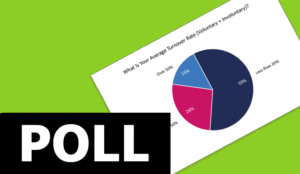Thibault Gilardoni at Odigo explains how there are hard and soft costs associated with contact centre turnover, the rates of which have been rising in recent years. Focusing on agent-centric issues, such as empathy fatigue, could help you stem the tide of agent attrition.
Turnover rates are a primary concern of contact centres the world over. If you are reading this post, chances are this issue concerns you at least a little.
You’re right to be concerned – a report by ContactBabel shows that agent attrition rates are not improving, remaining at around 20% since 2011. This figure draws attention to the obvious costs of contact centre turnover rates which are incurred simply through recruitment.
However, some other negative effects are more difficult to monetise, including the proportion of remaining staff that may well be dissatisfied and at best underperforming, at worst doing damage to brand reputation.
Furthermore, a 2021 survey by the CIPD showed that CEOs who were prioritising talent management had dropped to 30% from 48%. Likely the sudden demands of the pandemic have taken focus and attention, but when 81% of businesses trying to recruit experienced difficulties it is not something that can be ignored for long.
Onboarding and training to reach full potential takes time and money, delaying how quickly a team can be brought back to full numbers. The hard costs of agent attrition are stark and serious.
Symmetry of Attention and Its Role in Agent Attrition
Aside from those obvious hard costs, there are soft costs because you may be forced to run understaffed during the recruitment of new agents. These soft costs come in the form of:
- The disruption of smooth operations,
- Difficulty meeting KPIs such as call handling times,
- Customer dissatisfaction,
- Poor morale among agents.
The conventional approach to reducing contact centre turnover rates would be to fix the first three on the list and expect the subsequent benefits to trickle down to agents manning the phones.
However, in recent years, the overall focus in management has shifted to providing an improved employee experience alongside providing quality customer service. What implications does this approach have for easing agent attrition?
The thinking goes that happy employees make for happy customers, so it makes total sense to ensure symmetry of attention. Both are (as is every one of us) human beings after all.
Focusing on achieving results, as well as the agent experience delivering you those results, will pay dividends in both the short and long run and turn the tide on high rates of contact centre turnover. Achieving that symmetry, however, requires something of a shift in perspective of how your contact centre is managed and run.
Employee-Centric Issues That Contribute to Contact Centre Turnover Rates
Make no mistake, customer service can be demanding and stressful. The aforementioned ContactBabel report listed not being the right person for the job as the leading driver for contact centre turnover rates.
Some of the key contributors to that are dissatisfaction and monotony, leading to a feeling of disconnection with the agent role. This can be compounded if your contact centre still tends to rely on scripts to interact with customers.
Indeed, asking staff to mechanically stick to unnatural-sounding responses at all times can quickly become demotivating… especially if they were recruited for their personality and communication skills in the first place!
Excessive monitoring and prompting to stay on-script compounds this agent pain point, making staff feel more like animals in a zoo than contributors to your contact centre’s goals.
In order to provide excellent customer service, agents need the freedom to communicate and empathise fluidly with your customer base. Moreover, your customers respond better to talking to an agent who sounds like a human being and cares about the issues affecting them.
Empathy is a key part of the agent-customer relationship. On the other hand, heightened contact centre turnover rates can also be attributed to contact centre burnout, with excessive pressure or stress ranked as the 5th highest reason for staff attrition in the previously mentioned ContactBabel report.
When agents emotionally engage with a customer and their problems for extended periods of time without pause, it can lead them to disengage, which could lead to further attrition.
Possible steps to reduce burnout include lightening the workload of agents by putting emphasis on monotasking rather than multitasking, reducing schedule unpredictability and even regularly showing agents that they are appreciated.
Tools That Can Help Lower Contact Centre Turnover Rates
Addressing the employee-centric issues of high turnover requires a second look at attitudes toward your contact centre’s agents and their workloads. Improving workflow with software that operates via intuitive unified console reduces some of the small operational frustrations that can build up throughout a working day.
You can also improve the quality of your agents’ experiences by giving them choice and diversity in their tasks, and reduce time spent scheduling on the management side.
Author: Guest Author
Published On: 23rd Nov 2021 - Last modified: 9th Aug 2024
Read more about - Guest Blogs, Odigo, Thibault Gilardoni





































